april  2011
2011
It's election time in Canada again. Again. At least this time I'm getting the impression that it's not just me and my expatriate/ex-American cynical idealism or passive aggressivism that leads me to rank the prospect of getting out the vote somewhere around par with those "routine" dental cleaning appointments you're supposed to have every six months (and if you know anything about my dental history, you know this isn't a comparison I make lightly).
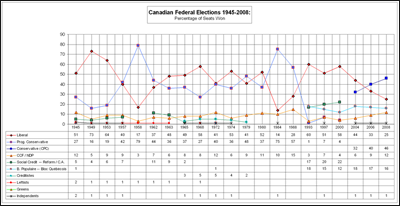 Unlike the United States, where they schedule their elections at four year intervals and everyone knows the exact date going backwards or forwards 100 years, like clockwork only more regular and predictable, Canada elects its national leaders at seemingly random intervals whenever who-in-the-hell-knows decides it's time. Admittedly, my perception is strongly biased in favor of not looking it up, getting sidetracked for 20 minutes — oh, let's be honest, probably much longer — and spending my weekend learning a bunch of shit about which I couldn't really give a rat's ass.
Unlike the United States, where they schedule their elections at four year intervals and everyone knows the exact date going backwards or forwards 100 years, like clockwork only more regular and predictable, Canada elects its national leaders at seemingly random intervals whenever who-in-the-hell-knows decides it's time. Admittedly, my perception is strongly biased in favor of not looking it up, getting sidetracked for 20 minutes — oh, let's be honest, probably much longer — and spending my weekend learning a bunch of shit about which I couldn't really give a rat's ass.
What Canada needs is a Rat's Ass Party. It could fill the void left by Marc Emery. Maybe I should throw my hat in the ring.
As I was saying, apparently, I'm not alone in greeting another election with a mix of aggravation and meh. The last election was in 2008 and voter turnout hit an all-time low of 59%, down from its peak in 1962 at around 79%. Now I haven't done the math or anything but could there be a correlation between the low voter turnout and the fact federal elections were held in 2000, 2004 and 2006 before that? Although I'm not willing to embark on a study of the miraculous trigonometry it would probably take to determine how much or how fast the interval between elections is shrinking, the trend seems to be moving toward more frequently. For a nation that doesn't tend (or need, but more on that in a minute) to deify its national leaders the same way, ahem, some nations do, more elections inevitably means more meh.
Here's a better way of comparing apples and oranges. Barack Obama is the 44th President of the United States, and they've been voting since 1776, often but not always electing the same person for two consecutive terms, but only once electing a President for a period longer than eight years. Meanwhile Stephen Harper, the current leader of the Conservative party, is Canada's 40th Prime Minister, but we've only been voting since 1867. See? More elections, less giving a rat's ass.
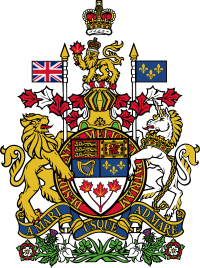 It may be of some interest to note that before 1867, the leader of our great fur-trapping, timber-cutting colonies was, then as now, none other than the King — although now of course, it's the Queen — of Canada. (Ugh, see this is what I get for reading the fine print.)
It may be of some interest to note that before 1867, the leader of our great fur-trapping, timber-cutting colonies was, then as now, none other than the King — although now of course, it's the Queen — of Canada. (Ugh, see this is what I get for reading the fine print.)
[Pictured at left, the Royal Canadian Coat of Arms. I know what you're thinking. Is that a unicorn on the right? You bet your ass that's a unicorn.]
A few weeks ago, as pre-election coverage was ramping up to Royal Wedding levels of comic oversaturation, CBC.ca launched a helpful tool called Vote Compass to promote voter participation in this great game we call participatory democracy or some such thing. A fast, fun personality test designed to map your views on all the supposedly key issues (more on that later) and show you where your beliefs put you on their uber-scientific X-Y axis as compared with the Big Five candidates. Sure, I took the bait — they had me at personality test.
The first time I took survey, it told me I should be voting NDP, which didn't sound too far off even though the Green party has been my party of choice in the last two elections. But when I took the test again just now (to generate the screen shots below, you're welcome), it told me I should be voting Green. I didn't think my answers had changed that much, although it's certainly possible that a critical percentage of my views were unwittingly refined by the little bit of reading I was able to accomplish this morning in my pre-election cram session (before I became annoyed and self-righteous and thought, fuck studying, I know enough to rant about this already).
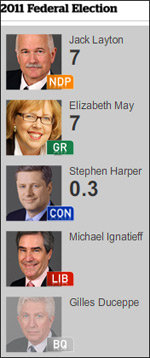 Lucky for me, though, the Vote Compass offers some even more helpful "extras" on their results page, like the one on the right, which shows you how each candidate scored when their views were matched against yours. So... I guess if two are tied for first place, they just pick one at random? Or maybe my choices didn't fluctuate so much as a hair between my first and second visits to their site, but this time Green won the coin toss over NDP. Boy, if I thought we lived in a world where the majority of voters were the type to take personality tests so seriously that they might easily be swayed by the results of something so apparently scientific (gee, I thought I was a Liberal but, gosh darn it, if the CBC says I'm a Conservative, it must be true)...
Lucky for me, though, the Vote Compass offers some even more helpful "extras" on their results page, like the one on the right, which shows you how each candidate scored when their views were matched against yours. So... I guess if two are tied for first place, they just pick one at random? Or maybe my choices didn't fluctuate so much as a hair between my first and second visits to their site, but this time Green won the coin toss over NDP. Boy, if I thought we lived in a world where the majority of voters were the type to take personality tests so seriously that they might easily be swayed by the results of something so apparently scientific (gee, I thought I was a Liberal but, gosh darn it, if the CBC says I'm a Conservative, it must be true)...
But anyway. Apparently the Vote Compass made enough people genuinely perplexed and some downright angry that they started posting about it on babble.ca, the blogging arm of rabble.ca, an independent media outlet here in Canada (hee, I almost wrote "outleft" — and yes, I know — we're adorable, aren't we?). Anyway, after a number of posts documenting the inconsistencies and recording the bewildered, outraged reactions of the far-left vs. center-left vs. far-center-left voters who like their dressing on the side, one contributor named Malcolm broke it down for the rabblers thusly:
So, if moderate Conservatives are told to vote Liberal and New Democrats are told to vote Green, cui bono?
The Liberals.
So, a bogus CBC election "tool" that benefits the Liberal Party of Canada.
I'm shocked, shocked...
It matters for the same boring, sad reason the two functionally identical parties in the US teamed up to shut Ralph Nader out of the 2004 debates, and subsequently the entire 2008 election, and why the only candidate who would go on record defending the rights of third party candidates to run was Pat "righter-than-Republican" Robertson, while the Democrats hid in the Green room and barricaded the door on the off-chance Nader might out-maneuver the rent-a-cops the network had hired to keep him out. If there's one candidate on the right and three on the left, even if the left has 60% of the vote overall, it could be evenly split between the three at 20% each, giving the 40% a grudging but inarguable majority. This, in a very dumbed-down nutshell, is what happened last time and why liberal, open-minded, compassionate Canada has a petroleum-breathing reptile with plastic hair for a Prime Minister.
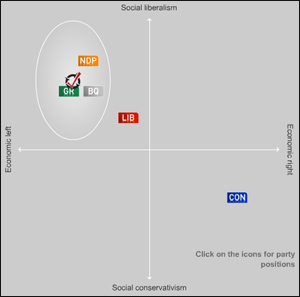 Which is what got me on this in the first place; a breathless phone call this morning "from" the office of Hedy Fry, Vancouver's incumbent Liberal candidate, telling voters that the race between her and the conservative candidate is heating up and urging everyone to get out there and vote for her, because she's the only thing standing between us and the reelection of the Lizard King. Which doesn't make a whole lot of sense, considering that Vancouver is one of a few reliably (lower-case) liberal districts in BC and if there was any threat to the Liberal candidate, it would more likely come from the left end of the spectrum (NDP or Green) than the right. See, there are five parties here and, if you'll refer to the X-Y axis chart on the left, you'll see how the views of four out of five parties tend to cluster in the upper-left quadrant.
Which is what got me on this in the first place; a breathless phone call this morning "from" the office of Hedy Fry, Vancouver's incumbent Liberal candidate, telling voters that the race between her and the conservative candidate is heating up and urging everyone to get out there and vote for her, because she's the only thing standing between us and the reelection of the Lizard King. Which doesn't make a whole lot of sense, considering that Vancouver is one of a few reliably (lower-case) liberal districts in BC and if there was any threat to the Liberal candidate, it would more likely come from the left end of the spectrum (NDP or Green) than the right. See, there are five parties here and, if you'll refer to the X-Y axis chart on the left, you'll see how the views of four out of five parties tend to cluster in the upper-left quadrant.
While a voter might have extremely strong feelings about a particular issue on which the left is divided, making a vote for NDP over Green ideologically inconceivable, generally speaking, if you throw a dart in Canadian politics... well, you get the idea. The fear that provoked this morning's phone call is likely a result of the news that the NDP is closing in on the Liberal party in the national polls for the first time, well, ever. Obviously the Liberal response to this is to try and stir up as much fear of a Conservative "majority" as possible among swayable voters who don't want to quibble over one or two issues, they just want to live somewhere in the upper-left quadrant and be left alone. Considering how most Canadians feel about American politics, it's ironic that they can be so easily motivated by fear to inch closer to that misguided one-party-masquerading-as-two-party system.
Not that I would take the recommendation of the Georgia Straight over that of the CBC just because they have a history of representing Vancouver's progressive population base, like any self-respecting free city paper does, but I did feel some small amount of vindication reading their slate for the 2011 federal election. During the last couple of elections, the paper lost a great deal of their progressive cred as far as I'm concerned by urging everyone to vote "strategically" (Liberal) on the same scare-mongering logic that has Hedy Fry's auto-dialer working through the weekend before the election. This year, though, they're recommending Green candidate Adriane Carr for downtown Vancouver.
PlanetWaves.net weighed in on the Birth Certificate today (geez, who knew there was even such a thing as a "long form"??). Astrologers learned nothing new, but this is priceless (if going-on three years too late):
"While we are on the subject of birth certificates and whether someone is a "natural born citizen," I just want to add this. According to his birth certificate, Sen. John McCain, who kind of almost became president in 2008, was not born in the United States... McCain was born in Panama. There is a rumor that he was born in the Canal Zone, which was then a placed leased by the U.S. government. That is arguably not a U.S. territory, but it would probably pass muster with a federal judge. You know, it sounds good, the Canal Zone and all. That's why they keep saying it...
But the city of Colon is not in the Canal Zone. It's just another city in Panama, and unlike Hawaii, Panama (while it has palm trees) ain't a state. Not only that, it isn't a state. It isn't a territory. It's a foreign country, where foreigners come from. But it's okay; McCain is a honkey." [PlanetWaves.net]
Here's something interesting. Normally I shy away from anything that advertises itself as "interactive multimedia entertainment," in part because I'm lazy and "interactive entertainment" will always strike me as something of an oxymoron. But also because that trio of words has been thrown around since the early Cretaceous era of the Internets and it's rarely been attributed to anything that actually succeeded at being either interactive or entertaining. The attempt to combine these two desirable traits into one creature has resulted in a lot of gimmicky flash (pun intended) and ill-advised pseudo-celebrity cameos. And as with most strategically engineered hybrids, they've been tragically maladapted to their environment but mercifully short-lived. And if I wanted to watch a badly directed/animated feature-length flash movie broken up into tiny pieces that I have to keep pointlessly clicking to get to the next chapter, I'll go to YouTube. At least there, with a small investment of effort and touchpad dexterity, I can make a playlist that will provide me with tens of minutes of uninterrupted entertainment.
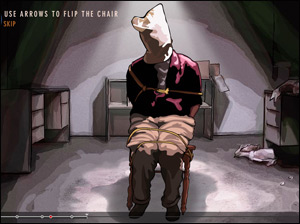 That being said, I fully (even interactively) enjoyed Collapsus: Energy Risk Conspiracy, the new, Webby-nominated (I know, whatever) feature-length live-action/animated docudrama politico-environmental thriller that you can watch like a movie but explore like, well, let's say a particularly robust DVD extras menu, with interactive bits that are quite creative and mentally challenging enough to make you feel engaged in the action, rather than manipulated like a lever-pressing lab rodent. Although I have to admit, I came very close to skipping ahead when I felt that I'd passed the reasonable threshold for giving it a try with the chair-tipping scene, but somehow I eventually got it (and if you're thinking it's probably timed... no. No one in their right mind would program it to take as long as I did).
That being said, I fully (even interactively) enjoyed Collapsus: Energy Risk Conspiracy, the new, Webby-nominated (I know, whatever) feature-length live-action/animated docudrama politico-environmental thriller that you can watch like a movie but explore like, well, let's say a particularly robust DVD extras menu, with interactive bits that are quite creative and mentally challenging enough to make you feel engaged in the action, rather than manipulated like a lever-pressing lab rodent. Although I have to admit, I came very close to skipping ahead when I felt that I'd passed the reasonable threshold for giving it a try with the chair-tipping scene, but somehow I eventually got it (and if you're thinking it's probably timed... no. No one in their right mind would program it to take as long as I did).
If you want to know more but don't quite know if you want to watch the whole thing, there's also a whole slew of videos, walkthroughs, trailers and interviews with the creators, a pdf presskit (that I couldn't open) and just to give it that extra level of "conspiracy" cred, a two-part interview with Alex Jones.
Lastly, I'll leave you with some delightful Better Book Titles or, as a related blog calls them, less pretentious and more descriptive. (Original titles and authors are below.)
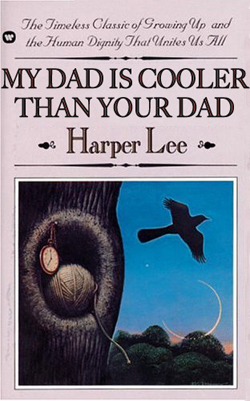
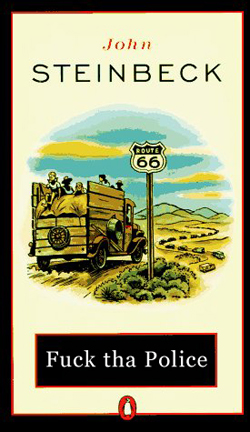
Harper Lee: To Kill A Mockingbird and John Steinbeck: The Grapes of Wrath
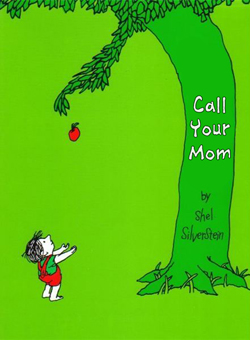
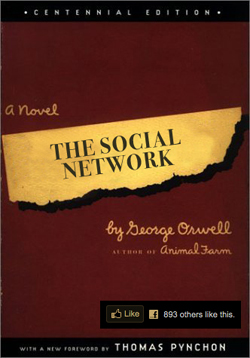
Shel Silverstein: The Giving Tree and George Orwell: 1984
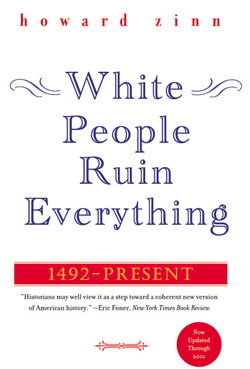
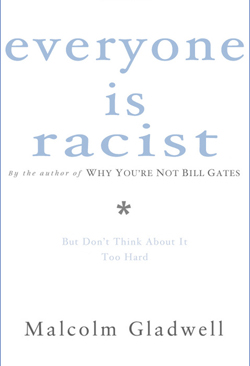
Howard Zinn: A People's History of the United States and Malcolm Gladwell: blink
I have absolutely nothing to say — I'll just say that right off the bat. Earlier in the day, I did. I was all set to actually put this random holiday to use but, after sleeping in well past the halfway point of a normal day, reading all the interesting articles in the February issue of WIRED, then scribbling furiously for several pages in a spiral notebook with a ballpoint pen, I think the left hemisphere of my brain went back to sleep. But... I'm not doing anything else right now so, rather than see how quickly I can antagonize Mr. Pink by enquiring "innocently" about the status of various household projects, I might as well take his advice and try to write about something. If nothing else, I've got a week to stave off the impending fail of posting a batch of recently-watched YouTube videos on the last day of the month in a desperate attempt to avoid April turning over undocumented, just because I lacked the motivation to type out a few words of wry social commentary, political snark or shameless self-absorbed pontification. After all, this needn't be a full State of the Navel Address...
So here's something interesting — a note I had written on a random page in that notebook some time ago, but hadn't stumbled back across since then. It said "Top 25 most recognizable scents," which fortunately did the trick and triggered the appropriate memory of whatever podcast I'd been listening to where the participants discussed a survey taken some time ago asking people to name the most recognizable smells, with the end result being some semblance of a scientific conclusion. I remembered thinking it would be ever so much fun to try to guess the top 25, or just pick my top 25 and then to look up the actual survey and see how they match the statistical average. I imagined that there would be several studies in a similar vein and that I would be able to compare them and analyze the contents based on the biases of their sponsors, like you can with "Best movies" lists.
 So, I started with a very strong ten, at which point I had to break off into a second list of "recognizable brands" versus generic scents, which seems like cheating but I defy you to list "cinnamon" and then move blithely on while your reptilian brain is screaming "Cinnabon" and inundating your visual cortex with its best approximation of scent memory — clear-as-day sensory immersion in the shopping mall archetype of your youth (Northgate Mall on Seattle's outskirts, unfortunately), and lurid close-ups of a faithfully-rendered Cinnabon specimen in various stages of consumption; the iconic Matterhorn configuration of sugar and cinnamon encrusted bread, a perfectly sculpted golden spiral formation that breaks away in perfect bite-sized curls to reveal steam-filled valleys of soft, sticky, buttery bliss inside, shrouded in an extravagant icing glaze that exists in a state of eternal tensile indecision, not-quite-solid, not-quite molten, which is perhaps singular to extreme sugars and volcanic magma.
So, I started with a very strong ten, at which point I had to break off into a second list of "recognizable brands" versus generic scents, which seems like cheating but I defy you to list "cinnamon" and then move blithely on while your reptilian brain is screaming "Cinnabon" and inundating your visual cortex with its best approximation of scent memory — clear-as-day sensory immersion in the shopping mall archetype of your youth (Northgate Mall on Seattle's outskirts, unfortunately), and lurid close-ups of a faithfully-rendered Cinnabon specimen in various stages of consumption; the iconic Matterhorn configuration of sugar and cinnamon encrusted bread, a perfectly sculpted golden spiral formation that breaks away in perfect bite-sized curls to reveal steam-filled valleys of soft, sticky, buttery bliss inside, shrouded in an extravagant icing glaze that exists in a state of eternal tensile indecision, not-quite-solid, not-quite molten, which is perhaps singular to extreme sugars and volcanic magma.
My two lists proceeded thusly, in order of when they occurred to me, not recognizability:
Top 25 recognizable scents:
|
Top 25 recognizable brand scents:
|
(*Punctuation and final item added triumphantly hours after I'd finished both lists and left the notebook in the other room. Yes, as a matter of fact I did exclaim "Noxema!" out loud, apropos of nothing like a crazy person, to which Mr. Pink said, "Oh my god, totally." )
Mr. Pink also had some very good additions to my original list when I mentioned it to him, including skunk, ammonia, paint, the ocean, peanut butter, fish, curry, tequila, nutmeg, cedar, chalk, leather, sawdust and newsprint. So then I went off to find the actual list to see how we did. First, there were only 20 items on the original list, but I have to say I think we did better than the people they surveyed...
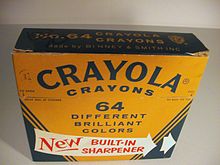 1. Coffee
1. Coffee
2. Peanut butter
3. Vicks VapoRub
4. Chocolate
5. Wintergreen oil
6. Baby powder
7. Cigarette butts
8. Mothballs
9. Dry cat food
10. Beer
11. Ivory bar soap
12. Juicy Fruit gum
13. Orange
14. Cinnamon
15. Lemon
16. Tuna
17. Banana
18. Crayons
19. Cheese
20. Bleach
So, it turns out this list was from a study conducted at Yale University with just 200 participants, likely students and probably mostly male (beer and Ivory soap?). Dry cat food is arguably the most random inclusion on the list and banana is just a complete flail. I can find no clue as to the date of the study, except it was prior to 1997 because the first article mentioning it was published by Salon.com in 1997. Get this, though — it is the only study of its kind on the whole Internet. No one before or since has been curious enough to conduct another, not even an equally unscientific one (none deemed worthy of uploading anyway). I find that shocking.
What has been done, although it's limited to maybe 5-10 scents per list, is this interesting BBC survey that groups nostalgic smells by decade. So, if you grew up in the seventies for example, the top scents you would recognize from childhood would be: baby powder, mother's perfume, moth balls, plastic, hair spray, suntan oil, chlorine, felt tip pens. Mmmmm, suntan oil and felt-tip pens... Switch out moth balls for gasoline (maybe throw in some Dr. Bronner's liquid soap) and it's a perfect list. It stops at the seventies, though, so if you're ten years younger than me... well, then you're ten years younger. What are you complaining about?
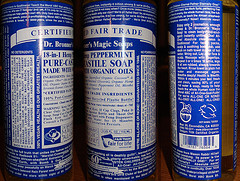 Speaking of Dr. Bronner's soap, though — funny story — about a month ago, we were sitting around the living room and suddenly I had this visual memory of the bottle sitting on the shelf beside the bathtub when I was a kid. "What was that hippie soap," I asked the room, "you know, it was a liquid soap and it had this weird whole earth manifesto written in a tiny, tiny font all over the label? It smelled like peppermint?" I don't know if it was the peppermint or the manifesto but I saw a flash of recognition on my friend's face and we pointed at each other to channel the lightning rod of collective memory. "Dr. something," she said, and that was enough for google to take over from there. So now we have our very own bottle of it on the bathroom counter and it's not as weird as I thought it would be. It smells nice (no flashbacks!) and it's ultra-nontoxic, which still matters to me even if we are all getting lethal doses of Iodine-131 and Cessium-137 from the slowest nuclear fail in history that no one is supposed to be concerned about.
Speaking of Dr. Bronner's soap, though — funny story — about a month ago, we were sitting around the living room and suddenly I had this visual memory of the bottle sitting on the shelf beside the bathtub when I was a kid. "What was that hippie soap," I asked the room, "you know, it was a liquid soap and it had this weird whole earth manifesto written in a tiny, tiny font all over the label? It smelled like peppermint?" I don't know if it was the peppermint or the manifesto but I saw a flash of recognition on my friend's face and we pointed at each other to channel the lightning rod of collective memory. "Dr. something," she said, and that was enough for google to take over from there. So now we have our very own bottle of it on the bathroom counter and it's not as weird as I thought it would be. It smells nice (no flashbacks!) and it's ultra-nontoxic, which still matters to me even if we are all getting lethal doses of Iodine-131 and Cessium-137 from the slowest nuclear fail in history that no one is supposed to be concerned about.
The media's mutual silence suicide pact is disconcerting enough, but it's infuriating to hear reasonable people parroting science-flavored sound bites I can only assume are being slipped to them via the nightly news. I don't know safe background levels or safe exposure numbers or the difference between milliseverts, microseverts and picocuries, although I do know there is a difference. The thing is, there are maximum safe exposure limits for a reason and considering the "what they don't know won't hurt us" attitude of most governments and the well-documented history of their absolutely criminal disregard for humanity, the weak, uneven legislation that stands between humanity and the fallout from its genocidal impulses is hardly reassuring.
It's not like the information isn't available. Here's a report called "Health risks of the releases of radioactivity from the Fukushima Daiichi nuclear reactors" which goes into a great deal of detail and throws around a lot of numbers but also explains that the issue is almost unfathomably complex and by no means is this situation of no concern to North Americans.
Then there are headlines from the Nuclear Information and Resource Service this week: "High radiation readings were again measured in seawater near Fukushima over the weekend. Of particular concern were high readings of Iodine-131. With its eight-day half-life, new spikes in Iodine-131 should not be found. This strongly suggests that melting of fuel and new radiation releases continue to occur."
And earlier this week: "U.S. EPA measurements from Hilo [Hawaii] show elevated levels of Iodine-131 and Cesium-137 in milk samples taken earlier this week (19 picocuries/liter of Cesium-137 and 18 picocuries/liter of Iodine-131 vs "acceptable" level of 3 picocuries/liter). This is of concern for people who may drink local milk, or eat local cheeses and meat from local livestock."
And also this: "The Austrian weather service, which has been monitoring radiation across the world and advising the International Atomic Energy Agency, said that releases of Cesium-137 at that time were already 20-60% those of Chernobyl and Iodine-131 releases were at 20%. Note: this updated release puts Cesium-137 releases at 50% those of Chernobyl."
It's not the end of the world (we're still 21 months away, right?) but it isn't nothing either. You just have to ignore the obvious bullshit which should trip alarms in your brain anyway, like when experts you've never heard of give smirking, dismissive answers in a press conference and compare a multiple-reactor meltdown to taking a commuter flight. Or when the same people who believe in the Rapture use their multi-billion dollar propaganda machine to make you think it's somehow unscientific or hysterical or racist to be concerned about radiation levels millions of times above normal all the way on the other side of the ocean. This is coming from people who believe that dinosaur fossils were planted in the ground to test our faith. Mine's being tested right now, let me tell you.